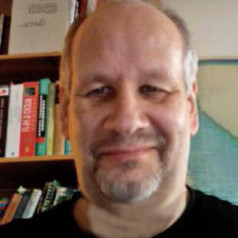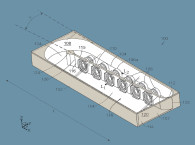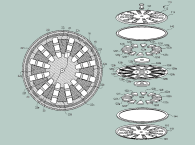
Desktop Audio Monitor System and Method
US Patent Number: 9036837
www.freepatentsonline.com/9036837.pdf
Inventors: James Tuomy (Framingham, MA),
Barry Michael Kosherick (Hudson, MA), Laurie Wilk
(Framingham, MA), and J. Richard Aylward (Ashland, MA)
Applicant/Assignee: James Tuomy (Framingham, MA),
Barry Michael Kosherick (Hudson, MA), Laurie Wilk
(Framingham, MA), and J. Richard Aylward (Ashland, MA)
Filed: June 17, 2010
US Classes: 381/160
Granted: May 19, 2015
Number of Claims: 18
Number of Drawings: 14
Abstract from Patent
A desktop audio loudspeaker system, for placement on a desktop used a work surface by a listener, includes an enclosure for placement on or above the desktop, the enclosure having a front surface; a first loudspeaker mounted in the enclosure, the first loudspeaker radiating sound from the enclosure, past the front surface, in a direct path to ears of the listener. This embodiment also includes a first reflective element having a surface, the first reflective element mounted in relation to the enclosure so as to reduce multipath effects caused by reflection of sound by the desktop, wherein the surface of the first reflective element is disposed transversely with respect to the front surface of the enclosure, and forming an angle with the front surface, to reflect sound, emanating from the first loudspeaker, away from the desktop in a direction that avoids a direct path to ears of the listener.

Independent Claims
1. A method of improving performance of a desktop loudspeaker system of the type having a loudspeaker in an enclosure for placement on or above a desktop used as a work surface, the work surface defining a horizontal plane, by a listener, who is positioned in front of the desktop and facing it in a manner that ears of the listener are positioned above the horizontal plane, the enclosure having a front surface, defining a front plane of the enclosure, the listener facing the front plane of the enclosure and wherein when the enclosure has been placed on or above the desktop, the loudspeaker radiates sound from the enclosure, past the front surface, principally in a direction generally normal to the front plane and in a direct path to ears of the listener thus positioned, the method comprising: providing a reflective element having a surface; and mounting the reflective element in relation to the enclosure, between the first loudspeaker and the desktop, so as to reduce multipath effects caused by reflection of sound by the desktop, by causing the surface of the reflective element to be disposed transversely with respect to the front plane of the enclosure, and forming an angle with the front plane, to reflect sound, emanating from the loudspeaker, that impinges on the surface of the reflective element, away from the desktop in a direction that avoids a direct path to ears of the listener, so that relatively little sound reaches the desktop to be reflected thereby and sound that is reflected by the reflective element lacks a direct path to ears of the listener and is thus attenuated and delayed when it does reach the ears of the listener.
7. A desktop audio loudspeaker system, for placement on or above a desktop used as a work surface, the work surface defining a horizontal plane, by a listener, positioned in front of the desktop in a manner that ears of the listener are positioned above the horizontal plane, the system comprising: an enclosure for placement on or above the desktop, the enclosure having a front surface defining a front plane of the enclosure; and a first loudspeaker mounted in the enclosure, wherein the enclosure and loudspeaker are configured so that when the enclosure is positioned on or above the desktop and the listener faces the front plane, the first loudspeaker radiates sound from the enclosure, past the front surface, principally in a direction generally normal to the front plane and in a direct path to ears of the listener thus positioned; and a first reflective element having a surface, the first reflective element mounted in relation to the enclosure, between the first loudspeaker and the desktop, so as to reduce multipath effects caused by reflection of sound by the desktop, wherein the surface of the first reflective element is disposed transversely with respect to the front plane of the enclosure, and forming an angle with the front plane, to reflect sound, emanating from the first loudspeaker, that impinges on the surface of the reflective element, away from the desktop in a direction that avoids a direct path to ears of the listener, so that relatively little sound reaches the desktop to be reflected thereby and sound that is reflected by the first reflective element lacks a direct path to ears of the listener and is thus attenuated and delayed when it does reach the ears of the listener.
15. A system according to claim 7, further comprising: a second loudspeaker mounted in the enclosure, the second loudspeaker radiating sound from the enclosure, past the front surface, principally in a direction generally normal to the front plane and in a direct path to ears of the listener thus positioned, the second loudspeaker radiating in a frequency range different from a frequency range of the first loudspeaker; a second reflective element having a surface, the second reflective element mounted in relation to the enclosure, between the second loudspeaker and the desktop, so as to reduce multi path effects caused by reflection of sound by the desktop, wherein the surface of the second reflective element is disposed transversely with respect to the front plane of the enclosure, and forming an angle with the front plane, to reflect sound, emanating from the second loudspeaker, that impinges on the surface of the second reflective element, away from the desktop in a direction that avoids a direct path to ears of the listener, so that relatively little sound reaches the desktop to be reflected thereby and sound that is reflected by the second reflective element lacks a direct path to ears of the listener and is thus attenuated and delayed when it does reach the ears of the listener.
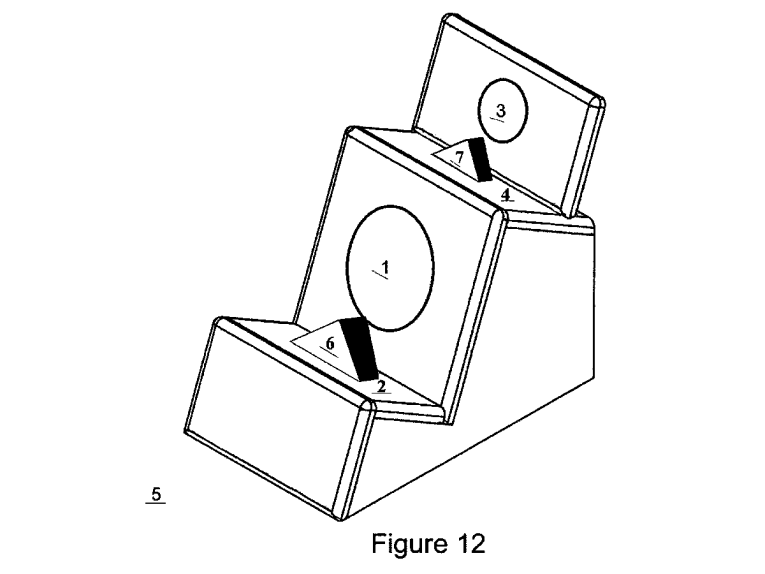
Reviewer Comments
The patent discloses a desktop loudspeaker system with the primary attribute addressing the problem of acoustical desktop surface reflections interfering with direct sound from the loudspeaker as the two signals sum at the listener’s ears. The inventors are all from the area around Framingham, MA, with at least one of them being the prolific — the late Richard Aylward was previously at Bose and has his name on many of Bose’s more interesting patents.
For many years the audible consequences of boundary reflections and direct sound interacting have been both recognized and there has been a debate on at least two categories of the interpretation of these reflections and interactions, and root causes of the measured and audible results. The first category is that of the audibility of correlated vs. uncorrelated reflections, or in this case, vertical vs. lateral reflections.
One camp doesn’t really discuss vertical reflections, but supports enhancing horizontal reflects, or doesn’t think there is a significant difference: “...doesn’t matter, reflections are reflections” as one currently retired industry expert and author voiced to this reviewer. The other camp finds the correlated, and vertical reflections (they can also come from the front wall) to be one of the most significant sources of tonal coloration.
Historically, going back many decades, at the macro scale, it has been found that correlated or vertical reflections have been a significant source of coloration in concert halls. The newer halls that house larger audiences tend to have lower ceilings and greater widths compared to some of the audibly favored. While older halls have relatively higher ceilings and narrower widths, creating a weaker vertical-to-lateral reflection ratio, which had been identified as one means for a lower performance hall coloration.
To take this to a more domestic-scale listening room, an interesting group of papers by Jorma Salmi and Anders Weckstrom, starting with their 1982 Audio Engineering Society (AES) paper “Listening Room Influence On Loudspeaker Sound Quality And Ways Of Minimizing It” isolated and explored, by way of a number of experiments—including straight wire bypass and anechoic vs. echoic rooms—the notion that correlated, vertical reflections were a primary source of perceived coloration from loudspeakers in rooms.
Early solutions for this issue in a domestic environment were vertically directive electrostatic and planar magnetic loudspeakers (often mistakenly touted more for their low mass diaphragms than for their vertical directivity advantages). Besides some of the professional dynamic driver line source systems, some of the earliest effective work in this area was from the late Peter Garland Snell, as disclosed in his 1976 patent, US Patent 3,964,571 “Acoustic System,” which spawned the well known Snell Type “A”, and more interestingly the largely unknown, Snell Type One (circa 1981).
Snell Type One used a rather longish (~30”), ramp extending forward out of the lower front of the enclosure, which served to harmonize the direct and floor reflected wavefronts, (very much like the loudspeaker equivalent of a PZM microphone) such that they summed in-phase at the listener. In rigorous double-blind tests, this was found to be one of the more neutral, low-coloration production loudspeakers ever made.
(To be clear, besides the elimination of floor reflection effects, the Snell Type Ones had exceptionally flat amplitude response and were left/right pair-matched within less than 1 dB.) Unfortunately, due to its domestically unfriendly appearance, its production was terminated after less than two years.

A second category of debate is between specular boundary reflections summing with direct sound at the listener and acoustic impedance boundary interaction with the transducer itself with the boundary reflection summing back at the driver, causing the driver to have a reduced excursion and output when ¼ wavelength from one or more boundaries. Authors Richard Cook and Richard Waterhouse, Roy Allison, and J.A.S. Angus have documented the latter viewpoint.
It turns out that both effects come into play, but are very different in their relationships to the number of boundaries and the directionality of the effect. The Allison Effect (as it is often referred to) is minimal for one ¼ wavelength distance boundary, increasing dramatically with each additional 1/4 wavelength boundary, and also is substantially omni-directionally consistent and listener-position independent in its measured effect. Whereas, the specular reflections are most significant for one boundary, and can actually decrease with each additional boundary of equal 1/2 wavelength direct/reflection differential, and the specular reflections vary depending on listener position.
Also, the Allison Effect is strongest at the first quarter wavelength boundary distance frequency, and for higher frequencies where the boundary distance is greater than ¾ wavelength, the effect virtually disappears. Specular reflections, on the other hand, can impact both low frequencies and can cause significant comb filtering well up into the midrange, and even higher, although the combing density increases with frequency to the extent that audibility in the higher frequencies is minimal.
There appears to be a dearth of literature addressing the two effects and their individual attributes. So, in terms of the invention under review (see Figure 1 and Figure 2), disclosed are a number of configurations of desk/table-top mounted loudspeakers, addressing the specular reflections off of the tabletop surface boundary and their potential interference with the direct sound.
Since the tabletop surface tends to provide a singular boundary reflection that is much stronger than reflected energy from other more distance boundaries, this use model can create the worst-case specular reflection problem of a single-boundary interference reflection.
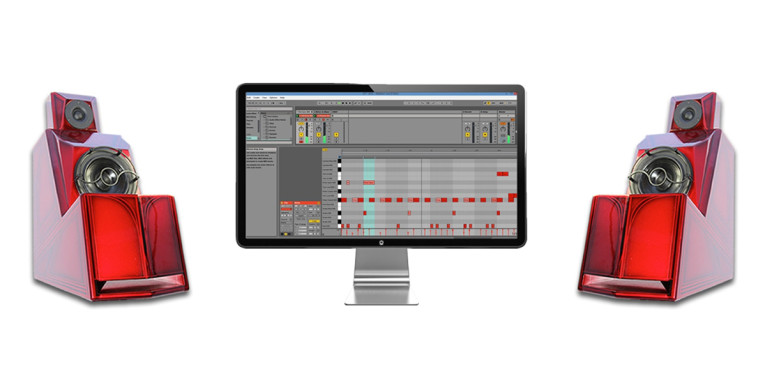
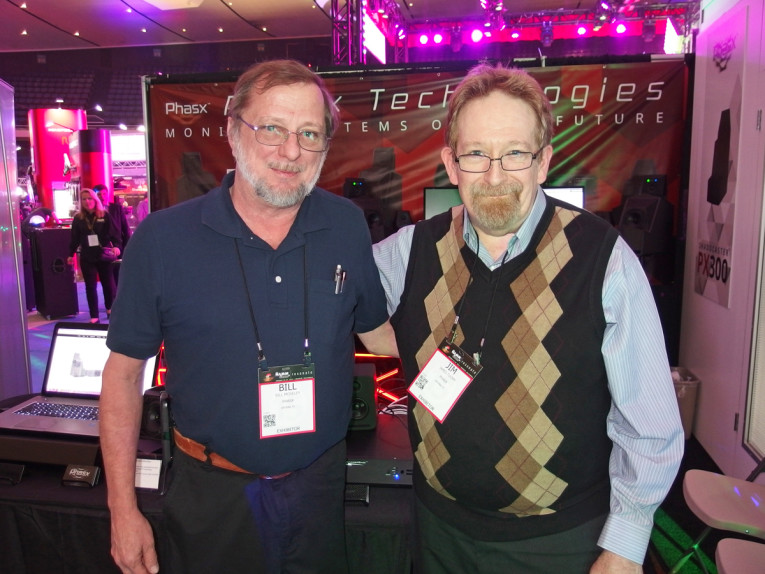
As a solution, the invention provides a reflective element having a surface mounted forward of the transducers and between at least a first transducer and the desktop, so as to reduce interference effects caused by reflection of sound by the desktop interacting with the direct sound as they both arrive at the listener. The surface of the reflective element is disposed transversely with respect to the front plane of the enclosure, and forms an angle with the front plane, to reflect sound waves emanating from the transducer, away from the desktop in a direction that avoids an efficient reflected wave path to ears of the listener.
The goal is to have relatively little sound reaching the desktop at the efficient reflection angle so that sound waves that are reflected by the reflective element lack a direct, energetic path to ears of the listener and thus attenuated and/or delayed such that the reflected wave no longer has adequate amplitude to significantly interfere with the direct sound arriving at the listener.
There are several configurations with different deflection angles. Most of the disclosed “reflective elements” are rather small compared to the longer wavelengths being reproduced by the table-top systems, the distance to the table boundary tends to be much shorter than floor standing/floor stand mounted systems, so the frequencies over which the table surface reflections cause problems tend to be higher frequencies with shorter wavelengths, so that smaller reflection surfaces can be effective in redirecting the reflected energy.
An interesting, alternative solution is disclosed in Vladimir Filevski’s AES paper “A Dipole Multimedia Loudspeaker” presented at the 120th AES Convention in 2006, which explores and addresses this same desktop, specular reflection, issue. Filevski examines a wide variety of configurations including directional horns and close boundary coupling, and ends up with an open dipole loudspeaker that is angled back to “direct” the dipole null at the desktop at the appropriate angle to substantially cancel the desktop reflection.
An effective variation on the Filevski dipole solution was developed independently several years earlier by Bruce Thigpen and David Graebener, both using their own versions of planar magnetic transducers to create both an open dipole system, one which also had greater vertical directivity.
All these systems can provide an effective improvement to a very audible problem that is most often ignored with tabletop devices. The embodiments disclosed in the currently reviewed patent should also provide useful solutions to the specular table surface reflection problem. VC
This article was originally published in Voice Coil, August 2015



